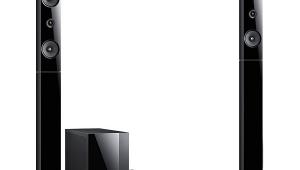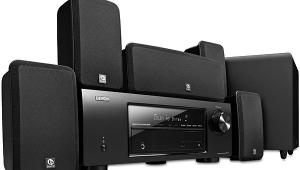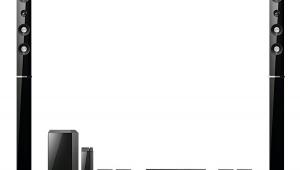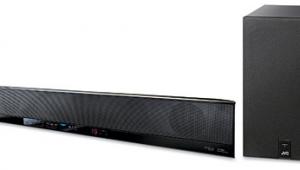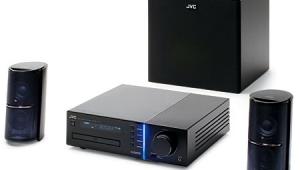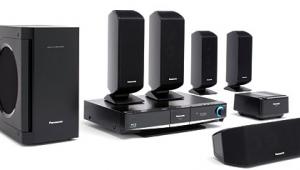Niro 1.1 Pro HTIB
Throw Niro Nakamichi's name at the iPod generation, and you'll stump the panel. To an older generation, however, Nakamichi's three-head cassette deck, the Nakamichi 1000, elevated the lowly cassette to the world of the best recording medium of the day, the cumbersome reel-to-reel tape deck. In a way, the Nakamichi 1000 was an iPod forebear in the miniaturization and portability of recorded sound. After the Nakamichi family sold the company name in 1998, Niro Nakamichi started Mechanical Research to develop big-ticket electronics like the awe-inspiring $22,000 Niro 1000 Power Engine monoblock amplifier.

Lately, he's turned to more-affordable, cross-generational products like the $799 Niro 1.1 Pro HTIB, available only via the Internet. To signal Nakamichi's devotion to the Internet, earlier this year, the stodgy-sounding Mechanical Research became niro1.com.
Five Drivers in One
The Niro 1.1 Pro won't stop you in your tracks like the Niro 1000 Power Engine—mostly because it's designed to be all but invisible. If this one-speaker, one-subwoofer, and one-DVD/receiver system is outrageous, it's only because of its promise to deliver surround sound from that single speaker cabinet. Physically, there's nothing remarkable about it, slick as it might be in the silver HTIB tradition. The DVD/receiver is retro basic, the subwoofer cabinet sounds like a hollow coconut when tapped with a knuckle, and the speaker looks like the basic HTIB center channel when you view it straight on. From a skycam view, however, the speaker is deeper than a standard center channel, and the grille wraps around either side.
Peel off that grille, and you'll begin to understand what Nakamichi is up to. Each side panel holds two 3-inch drivers with a fifth 3-incher anchored to the front panel. The driver alignment reflects Nakamichi's incarnation of virtual surround, which the company calls Niroson Cinema 1.1. It's a variation on head-related transfer-function algorithms, the psychoacoustic technology used by other virtual-surround formats like Virtual Dolby, SRS Circle Surround, and Spatializer.
Despite its single speaker enclosure, the Niro 1.1 Pro supports both popular multichannel formats: Dolby Digital 5.1 and DTS. When I ran a test DVD's channel-identification track, I noted that the front-channel signal actually feeds the rear driver on each side, while the surround-channel information is fed simultaneously to the front driver on each side. The front-panel driver serves basic center-channel duty.
 The receiver handles the number-crunching (about 600 million calculations per second) to determine what signal goes to each driver. The company says that the virtual-surround effect doesn't rely on reflections from nearby walls, so the speaker's placement isn't critical. The average consumer doesn't care about head-related transfer functions; but, for those gearheads out there, you'll find more information at http://interface.cipic.ucdavis.edu/CIL_html/CIL_whatis.htm. The number-crunching that matters is how 5.1 is distilled to 1.1.
The receiver handles the number-crunching (about 600 million calculations per second) to determine what signal goes to each driver. The company says that the virtual-surround effect doesn't rely on reflections from nearby walls, so the speaker's placement isn't critical. The average consumer doesn't care about head-related transfer functions; but, for those gearheads out there, you'll find more information at http://interface.cipic.ucdavis.edu/CIL_html/CIL_whatis.htm. The number-crunching that matters is how 5.1 is distilled to 1.1.
The Niro 1.1 Pro has no speaker wire per se, only ribbon-style connectors running from the speaker and subwoofer to the receiver. The 14-pound subwoofer has no dedicated power cord or controls. The muted-black cabinet with a gray cloth grille is bare except for a port and a connector wire the size of lamp-cord wire on the base.
The Niro system might as well have been custom-made for the Samsung TXN3071WHF 30-inch TV in my 11- by 14-foot room. The speaker rested atop the Samsung, a perfect silver-on-silver match. The natty receiver features five 30-watt digital amplifiers for the main channels and a 50-watt digital amp for the subwoofer. A rear-panel cooling fan, audible after the Niro is fired up for about a half-hour, expels excess heat. The receiver also has a progressive-scan DVD player and an AM/FM tuner.
The rear-panel connections come straight out of the Jurassic era. The video basics are covered, but there are no digital-audio connections and no 5.1-channel analog audio inputs for DVD-Audio or SACD. Niro promises more options on future versions of the Pro. The remote performs only basic functions—and not too handily, thanks to its puny buttons. It's not a learning remote, so you can't program it to operate, say, your TV.
The Niro 1.1 Pro takes just minutes to set up. There's no speaker calibration to worry about, but niro1.com strongly recommends setting the speaker in an unconfined space at least 6 feet from the listening position. You can taper the system's sound, only slightly, by adjusting controls for the subwoofer and tone. Even though I positioned the subwoofer in a corner, where its output should be maximized, I still had to boost the level. Other than that, this was a no-tinker job.
The Power of 1.1
It took about five seconds—long enough to hear the MGM Lion's roar fill the room after loading the West Side Story DVD—to realize that the Niro 1.1 Pro meant business. This film sounded every bit as good through the Niro as it did through a half-dozen 5.1 HTIBs I've auditioned. A lot of under-$1,000 HTIBs, with those little soup-can speakers, sound anemic even on their best days. The Niro couldn't spin a 360-degree soundstage, but it certainly could stretch out to 180 degrees, like what you'd get from a good two-speaker system using Virtual Dolby.
Play "Hakuna Matata" from The Lion King, and you'll clearly hear the warthog from the center and the music panning left to right and into the room. The belch resonated as it should. The final chorus ran a little nasally, but the sound effects were superb. It's definitely not full-blown surround sound—just a big, pleasant sound.
"The Halftime Show" from Drumline showed off the sub's surprising heft. With enough convincing bass, the marching band sounded legit. Running some test tones through the Niro rattled the lightweight sub but suggested usable response down to about 30 hertz, a surprising result from this HTIB wannabe.
"Coyote," Joni Mitchell's contribution to The Last Waltz, played so big through the Niro that it shocked my ears. The sound pushed way out into the room. Even though I wasn't exactly surrounded by sound, it felt like I was. When I played Van Morrison's "Caravan," the results were indeed loud, dynamic, and clear.
Don't Say a Word, the glossy 2001 thriller with Michael Douglas, came the closest to generating true surround sound through the Niro; I could hear the sea gulls trailing a boat to my side.
Two-Channel Challenge
CDs were a challenge. The two listening modes—stereo (which engages the rear two drivers only) and Pro Logic (which engages the rear two drivers, de-emphasized, and the center-channel driver)—are problematic. I much preferred the stereo setting's wide, laid-back, diffuse sound, even though imaging was atrocious. When Tierney Sutton sang "I'll Be Around" from Dancing in the Dark, she meant it; her voice was around, somewhere, everywhere—almost if her voice came from behind the TV. The Pro Logic setting brought her voice into focus, but at the expense of the soundstage, which collapsed.
With Aimee Mann's "Ghost World" from the Bachelor No. 2 SACD/CD hybrid, the instrumentation infringed on her vocals in stereo mode. In Pro Logic, vocal prominence was restored, but the sound was muddied and the soundstage diminished.
It wasn't always like that, though. When I played "Theme from Shaft" from the Fantasy SACD/CD hybrid reissue of Isaac Hayes' still-cool Shaft soundtrack in stereo mode, I couldn't believe all that sound was coming from two little drivers. Right on!
Despite its limitations, the Niro 1.1 Pro solves a lot of the logistical problems of a full-size home theater. I'd recommend it only when space prohibits anything bigger. The Cambridge SoundWorks MegaTheater 505 is a complete 5.1 system that, at $550, the Niro can't touch in price or performance. If you're stuck on small, the Zvox 315, a one-box, four-speaker sound system that connects to anything from a TV to a PC and doesn't require an A/V receiver, costs $200. However, if movies get your blood bubbling and a full-size home theater is out of the question, the Niro 1.1 Pro will be a real crowd-pleaser. Guaranteed.
Highlights
• Strength in numbers: 1.1
• Easy-does-it installation
- Log in or register to post comments
